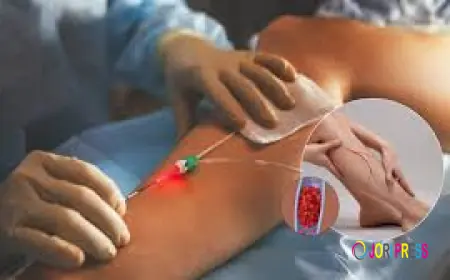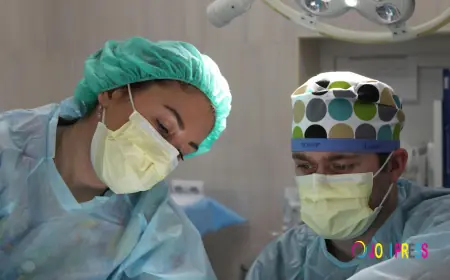Riyadh: Advanced Back Pain Technologies?
For those seeking advanced Back Pain Treatment in Riyadh, Jeddah and Saudi Arabia, the region is increasingly becoming a hub for cutting-edge medical technologies.

Back pain is a widespread issue, affecting a significant portion of the global population at some point in their lives. From dull aches to debilitating sharp sensations, it can severely impact daily activities, productivity, and overall quality of life. While traditional approaches involving rest, medication, and basic physical therapy remain foundational, the landscape of pain management is constantly evolving. Today, individuals suffering from persistent or severe back pain have access to a new generation of advanced technologies designed to offer more precise diagnosis, targeted relief, and potentially faster recovery. These innovations are reshaping how back pain is understood and treated, offering renewed hope for many.
The Challenge of Back Pain
Back pain is complex, often stemming from a variety of causes including muscle strains, ligament sprains, disc problems (like herniation or degeneration), arthritis, nerve compression, and even postural issues. Its chronic nature in many cases makes it a particularly challenging condition to manage, often requiring a multifaceted approach tailored to the individual's specific diagnosis and lifestyle. The search for effective and sustainable relief drives continuous innovation in the field.
The Role of Technology in Pain Management
Technological advancements are revolutionizing pain management by offering solutions that are less invasive, more targeted, and often lead to better long-term outcomes. These innovations span diagnostic tools that provide clearer insights into the source of pain, to therapeutic devices that offer sophisticated relief mechanisms, and even rehabilitative technologies that empower patients in their recovery journey. The goal is to move beyond simply masking symptoms and instead, address the root cause of discomfort with greater precision.
Advanced Back Pain Treatment in Riyadh, Jeddah and Saudi Arabia: A Modern Approach
For those seeking advanced Back Pain Treatment in Riyadh, Jeddah and Saudi Arabia, the region is increasingly becoming a hub for cutting-edge medical technologies. Healthcare providers are adopting innovative tools and techniques that offer more precise diagnostic capabilities, less invasive treatment options, and comprehensive rehabilitation programs. This modern approach to back pain aims to not only alleviate symptoms but also to improve long-term spinal health and function.
Precision Diagnostics: Pinpointing the Problem
Accurate diagnosis is the cornerstone of effective back pain treatment. Advanced technologies allow specialists to gain a more detailed understanding of the underlying issues causing discomfort.
-
High-Resolution MRI and CT Scans: While standard MRI and CT scans are common, advancements in resolution and sequencing provide even finer details of soft tissues, nerves, and bone structures, helping to identify subtle disc abnormalities, nerve impingements, or early signs of degenerative changes that might be missed on conventional imaging.
-
Dynamic X-rays and Fluoroscopy: These imaging techniques capture images while the body is in motion or during specific maneuvers, allowing clinicians to assess spinal instability or how certain movements contribute to pain. Fluoroscopy, a real-time X-ray, is also invaluable for guiding precision injections, ensuring medication is delivered exactly to the source of pain.
-
Electromyography (EMG) and Nerve Conduction Studies (NCS): These tests measure electrical activity in muscles and nerves, helping to diagnose nerve root compression, neuropathy, or other nerve-related conditions that contribute to back pain and radiating symptoms. They can pinpoint the exact nerve involved and the extent of damage.
These advanced diagnostic tools empower healthcare professionals to formulate highly targeted treatment plans, moving beyond generalized approaches to highly individualized care.
Minimally Invasive Interventions: Targeted Relief
A significant trend in modern back pain management is the shift towards minimally invasive interventions. These procedures offer effective relief with smaller incisions, less tissue disruption, reduced pain, and often faster recovery times compared to traditional open surgeries.
-
Epidural Steroid Injections: Guided by fluoroscopy or ultrasound, these injections deliver corticosteroids and local anesthetics directly into the epidural space around the spinal nerves. They are highly effective in reducing inflammation and pain caused by nerve compression from herniated discs or spinal stenosis.
-
Radiofrequency Ablation (RFA): For chronic back pain originating from facet joints (small joints in the spine), RFA uses heat generated by radio waves to ablate (burn) the specific nerves transmitting pain signals from these joints. This provides prolonged pain relief by interrupting the pain pathway.
-
Spinal Cord Stimulation (SCS): For persistent, severe chronic back pain that hasn't responded to other treatments, SCS involves implanting a small device under the skin that sends mild electrical pulses to the spinal cord. These pulses interfere with pain signals traveling to the brain, replacing them with a more pleasant tingling sensation or simply reducing the pain.
-
Vertebroplasty and Kyphoplasty: These procedures are used to treat vertebral compression fractures, often caused by osteoporosis. Bone cement is injected into the fractured vertebra (vertebroplasty) or a balloon is first inflated to create space before cement injection (kyphoplasty). These techniques stabilize the fracture, reduce pain, and restore vertebral height.
-
Endoscopic Spine Surgery: This advanced surgical approach uses tiny incisions and a small camera (endoscope) to visualize and operate on spinal structures. It allows for highly precise removal of herniated disc material or bone spurs, resulting in less muscle damage, reduced post-operative pain, and quicker recovery compared to traditional open surgery.
These interventions offer potent relief for specific pain generators and are a testament to the advancements in Back Pain Treatment in Riyadh, Jeddah and Saudi Arabia.
Rehabilitation and Therapeutic Technologies: Empowering Recovery
Beyond direct medical interventions, technology plays a crucial role in the rehabilitation and long-term management of back pain, fostering active patient participation and better outcomes.
-
Robotic-Assisted Rehabilitation: Robotics are increasingly integrated into physical therapy, providing precise assistance and resistance during exercises. For back pain, robotic devices can help individuals perform specific movements with correct form, gradually building strength and mobility in a controlled environment.
-
Virtual Reality (VR) Therapy: VR is emerging as a powerful tool for pain management and rehabilitation. Immersive VR environments can distract patients from pain, make therapeutic exercises more engaging, and provide visual feedback for posture correction and movement retraining. This can be particularly effective for chronic pain by addressing its psychological components.
-
Wearable Technology and Sensors: Smart wearables and sensors can monitor posture, movement patterns, and activity levels throughout the day. This real-time data provides valuable insights for both patients and therapists, allowing for immediate feedback on potentially harmful movements and guiding personalized exercise programs to prevent re-injury and promote healthy habits.
-
Advanced Electrophysical Modalities: Beyond traditional TENS units, newer electrophysical therapies, such as high-intensity laser therapy or targeted electromagnetic field therapy, are being explored for their anti-inflammatory and pain-relieving effects on deep tissues.
-
Tele-Rehabilitation Platforms: The rise of telehealth has made remote physical therapy and rehabilitation more accessible. Patients can receive guidance from therapists, perform exercises, and monitor their progress from the comfort of their homes, making consistent engagement easier, especially for those with mobility limitations or residing in remote areas.
These technologies are transforming the patient experience, making rehabilitation more engaging, effective, and convenient, ultimately contributing to sustained pain relief and improved function for those seeking Back Pain Treatment in Riyadh, Jeddah and Saudi Arabia.
The Future of Back Pain Management: A Collaborative Approach
The continuous evolution of advanced back pain technologies highlights a future where treatment is increasingly personalized, less invasive, and more focused on empowering the patient. However, the most effective outcomes are typically achieved through a collaborative approach, combining these innovative technologies with established principles of care.
Integrated Care Teams
A truly comprehensive approach to back pain involves a multidisciplinary team. This may include spine surgeons, pain management specialists, neurologists, physical therapists, occupational therapists, chiropractors, and even psychologists. This integrated team works together to evaluate the patient's condition from all angles, considering physical, emotional, and lifestyle factors to develop a holistic treatment plan. The advanced diagnostic and therapeutic technologies serve as powerful tools within this collaborative framework.
Patient Education and Self-Management
While technology offers incredible solutions, patient education and active self-management remain vital. Understanding the nature of their back pain, learning proper body mechanics, engaging in regular exercises, maintaining a healthy weight, and managing stress are crucial for long-term success. Advanced technologies can augment these self-management strategies by providing real-time feedback and engaging platforms for exercise and mindfulness. Empowering patients to take an active role in their recovery journey is key to sustained relief and preventing recurrence.
Research and Development
The field of back pain treatment is dynamic, with ongoing research continually pushing the boundaries of what's possible. From novel regenerative therapies like Platelet-Rich Plasma (PRP) and stem cell treatments being explored for tissue repair, to further refinements in neuromodulation devices and robotics, the future promises even more sophisticated and effective solutions for individuals suffering from back pain. These developments will continue to enhance the capabilities available for Back Pain Treatment in Riyadh, Jeddah and Saudi Arabia.
Frequently Asked Questions
As technology advances, questions naturally arise about the latest options for back pain relief. Here are some commonly asked questions regarding advanced back pain technologies.
Many Are Curious: Is advanced back pain technology only for severe cases?
Not necessarily. While advanced technologies are indeed crucial for complex and severe back pain cases that haven't responded to conventional treatments, many innovations are also beneficial for less severe conditions or for preventive care. For example, advanced diagnostics can pinpoint subtle issues early on, preventing progression. Furthermore, technologies like wearable sensors for posture correction or VR for engaging rehabilitation can be used by individuals with mild to moderate pain to improve daily habits and strengthen their back proactively, preventing future flare-ups.
People Often Ask: Are these advanced treatments readily available in Riyadh and Jeddah?
Yes, cities like Riyadh and Jeddah are increasingly investing in and adopting advanced medical technologies, including those for back pain management. Many specialized hospitals, spine centers, and rehabilitation facilities in these cities offer a range of cutting-edge diagnostic imaging, minimally invasive surgical options, advanced interventional pain procedures, and modern physical therapy modalities. It's advisable to consult with a local spine specialist or pain management expert who can guide you to the appropriate centers and available technologies.
Frequently Wondered: How long does recovery typically take after advanced back pain procedures?
The recovery time after advanced back pain procedures varies significantly depending on the specific technology or intervention used. Minimally invasive procedures, such as epidural injections or radiofrequency ablation, often have very short recovery times, sometimes allowing patients to resume normal activities within a day or two. More involved procedures like endoscopic spine surgery might require a few weeks of restricted activity and a structured physical therapy program. Your specialist will provide a detailed and personalized recovery timeline based on your specific procedure, overall health, and commitment to rehabilitation.
Commonly Inquired: Can I combine different advanced back pain technologies for better results?
In many cases, yes, a multidisciplinary approach that combines different advanced back pain technologies can lead to more comprehensive and effective results. For instance, advanced imaging might precisely identify the source of pain, followed by a targeted injection for immediate relief, and then integrated with technology-assisted physical therapy and wearable devices for long-term strengthening and posture correction. A spine specialist or pain management team can develop an individualized treatment plan that strategically combines various advanced technologies and traditional therapies to address all aspects of your back pain for optimal outcomes.
What's Your Reaction?
 Like
0
Like
0
 Dislike
0
Dislike
0
 Love
0
Love
0
 Funny
0
Funny
0
 Angry
0
Angry
0
 Sad
0
Sad
0
 Wow
0
Wow
0

















































